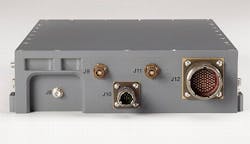Rockwell Collins provides prototype differential GPS for JPALS risk reduction
PATUXENT RIVER NAS, Md., 12 Aug. 2015. U.S. Navy shipboard electronics experts needed a precision Global Positioning System (GPS) satellite navigation system for a differential GPS-based carrier landing system. They found their solution from Rockwell Collins in Cedar Rapids, Iowa.
Officials of the Naval Air Systems Command at Patuxent River Naval Air Station, Md., have announced their intention to begin risk-reduction efforts involved in integrating the Rockwell Collins next-generation Digital Integrated GPS Anti-jam Receiver (DIGAR) into the Navy Joint Precision Approach Landing System (JPALS).
JPALS is an all-weather, all-mission GPS-based landing system for airports on land and aircraft carriers at sea that provides landing guidance for fixed-wing aircraft and helicopters. It features anti-jam protection for operating in electronic warfare (EW) environments.
The system will help land fixed-wing aircraft and helicopters in bad weather by substituting precise differential GPS technology for the RF beacons used in older instrument landing systems. The Raytheon Co. Integrated Defense Systems business in Tewksbury, Mass., is the overall JPALS contractor.
The Rockwell Collins DIGAR offers GPS receiver technologies and digital anti-jam beam forming technologies in one unit. Company engineers designed the satellite navigation system to meet stringent anti-jam and accuracy requirements like JPALS.
DIGAR protects against electronic warfare (EW) threats and guarantees phase stability for use with high-performance, real-time kinematic processing applications.
The unit has 16 dedicated L1/L2 anti-jam beams; antenna interface to seven-element CRPA; all-in-view satellite tracking; fast direct-Y acquisition; fault detection and exclusion per DO-229; switchable C/A or P(Y) code operation; growth to M-code; and pseudo-range and carrier phase measurement outputs.
The system has the latest Rockwell Collins 24-channel selective availability anti-spoofing security module (SAASM), including the latest key data processor (KDP II), company officials say.
Navy officials say they plan to award a GPS risk-reduction contract to Rockwell Collins sole-source because the company is the only source with the requisite knowledge, experience, and technical data necessary to provide the required, highly complex services.
The upcoming contract will ask Rockwell Collins to provide two advanced DIGAR prototypes for test and evaluation. Rockwell Collins is the sole designer, developer, systems integrator, and original equipment manufacturer of the navigation and communication equipment used for JPALS, Navy officials say.
For more information contact Rockwell Collins online at www.rockwellcollins.com, or Naval Air Systems Command at www.navair.navy.mil.

John Keller | Editor-in-Chief
John Keller is the Editor-in-Chief, Military & Aerospace Electronics Magazine--provides extensive coverage and analysis of enabling electronics and optoelectronic technologies in military, space and commercial aviation applications. John has been a member of the Military & Aerospace Electronics staff since 1989 and chief editor since 1995.

